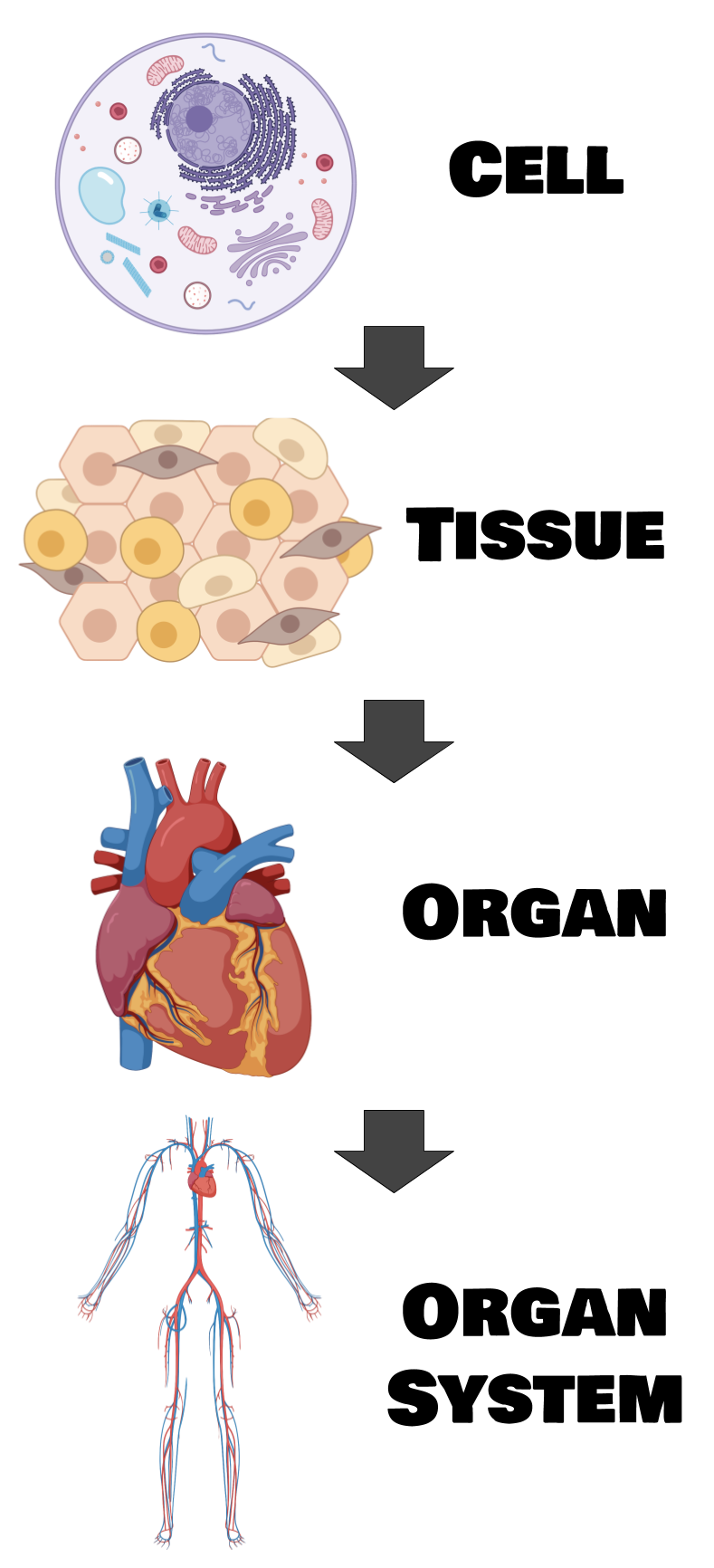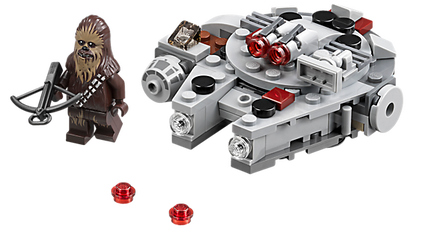What are bodies made of?
Cells and tissues
|
In this unit, we’re going to talk about a lot of really, really cool and exciting stuff that your body does to keep you alive, and we’re going to talk about how your body does all of those things. We also just finished a unit on cells and some of the really, really cool and exciting things that they do, like the chemical reactions that make energy. But, before we get into the details of how your body works, we want to remind you of one very important thing, which is quite possibly the most important thing you will learn this entire unit. Just like how everything that happens in a cell happens because of biochemistry, everything that happens in your body is because of something happening inside of your cells (which is happening because of biochemistry).
Cells are really important. Cells are so important that you have tens of trillions of them inside of your body. Once again, everything that happens inside of your body happens because of a cell. All of these cell types are just a little bit different, each with a different job that makes it possible for you to be alive and do all sorts of amazing things. Organ and organ systemThe tissues in your body are organized into tissues, which are organised in We’ll learn about each of the most important organs and organ systems in this unit. If you’d like a sneak-preview, here’s a great video:
|
Specialization
Since many cells have different jobs, they are specialized in order to be the best at their jobs. Remember way back when we first talked about cells? We said that cells are kind of like really awesome, living Lego pieces that all fit together to make you. Well, if you’ve ever made a complicated Lego structure, you know that not all Legos are exactly alike. There are little ones, big ones, round ones, slanted ones, ones that look like tiny people, ones that look like tiny people’s hats, and all sorts of other ones. And why are there different pieces? Because they all have different purposes. They do different things. They fit together in different ways. And all that uniqueness comes together to make something pretty freaking cool. Your body is the same way: different cells with different structures and functions coming together to make something pretty freaking cool.
|
© Lego
This Lego Millenium Falcon™ (and Chewbacca) has all sorts of different kinds of Legos that have different purposes but go together to make something cool. Cells are like the body’s Legos, and the body is at least as cool as a toy Millenium Falcon™. |
I could go on and on about the ways that your body’s cells work together to make life possible, but we’ll get into the specifics later. For now, there are two very important lessons for you to remember here, which we see all over biology and will keep seeing throughout this course. First:
Structure gives rise to function
In your body, many different cell types, each with unique structures that give them unique functions, can come together and work in perfect harmony to do everything that is needed to keep you alive. There are nerve cells, which have lots of spindly bits to help them receive information and a really long bit that helps them to send information. This unique structure gives them the unique function of sending, storing, and receiving information in your brain and all over your body. This unique structure also gives it the unique function of working with muscle cells, in perfect harmony, to tell the muscle cell when to squeeze (contract) to make you move. This muscle cell also has its own perfect, unique structure—long, stretchy, and packed full of specialized proteins—that make it possible for that muscle cell to contract in response to electrical signals from your nerves. That muscle can only move because it’s attached to something—bone—which also has its own unique structure and function that makes it strong and sturdy. It also couldn’t do anything without the energy that it gets with the help of the cells in your digestive system, which have unique structure for the unique function of digesting food and getting nutrients into your body, or the cells of your bloodstream, which have a unique structure for the unique function of carrying lots of oxygen to every tiny corner of your body, or the cells of your heart, which are extra-special muscle cells that have a unique structure for the unique function of constantly pumping blood in a perfect, controlled way. Structure gives rise to function.
You don’t need to know the exact details of muscle contraction for this class, but it can be helpful to see the structures and mechanism that I’m talking about to hit home the idea of structure and function being closely related. Here’s a video; watch how the shapes all come together and think about how those shapes are important for muscle contraction:
You don’t need to know the exact details of muscle contraction for this class, but it can be helpful to see the structures and mechanism that I’m talking about to hit home the idea of structure and function being closely related. Here’s a video; watch how the shapes all come together and think about how those shapes are important for muscle contraction:
cellular diversity is good
Second important lesson:
Not only is it important that all of your body’s cells have unique structures that give them unique functions, but it is also incredibly important that it has lots of cell types in the first place. Diversity is good in all sorts of contexts, but, in biology, there are a few especially important reasons for diversity. We’ll talk about each of these reasons at some point during this course, but for now we’ll focus on the key aspect that relates to diversification of cell types. That is, when lots of different things (in this case, cell types) come together, they can make something a lot cooler and more complex than they could separately.
This concept is known as synergy and is related to the principle of specialization. Each cell type is really good at a different thing, so it pretty much just does that one thing. This frees up other cell types to do just what they’re really good at, which makes the system a whole lot more efficient. People are the same way: For example, we have people who are really good at growing and farming food, so they do that, and we just buy it at the grocery store. That frees up a ton of time for us to do all sorts of things, like learn science. We have doctors who provide medicine, lawyers that provide legal help, factory workers that make stuff, business people who sell that stuff, scientists who learn new things and fix important problems, and so on, all doing what they’re good at so that we don’t all have to do everything. This is what makes it possible to form an advanced society: otherwise, we’d all just be fending for ourselves, trying to find food. Connecting this idea back to cells, if they didn’t specialize and help each other out, the world would be full of single-celled organisms just fighting for food and never doing cool things like making people. Diversity. Is. Good.
This concept is known as synergy and is related to the principle of specialization. Each cell type is really good at a different thing, so it pretty much just does that one thing. This frees up other cell types to do just what they’re really good at, which makes the system a whole lot more efficient. People are the same way: For example, we have people who are really good at growing and farming food, so they do that, and we just buy it at the grocery store. That frees up a ton of time for us to do all sorts of things, like learn science. We have doctors who provide medicine, lawyers that provide legal help, factory workers that make stuff, business people who sell that stuff, scientists who learn new things and fix important problems, and so on, all doing what they’re good at so that we don’t all have to do everything. This is what makes it possible to form an advanced society: otherwise, we’d all just be fending for ourselves, trying to find food. Connecting this idea back to cells, if they didn’t specialize and help each other out, the world would be full of single-celled organisms just fighting for food and never doing cool things like making people. Diversity. Is. Good.
Summary
This video gives a good recap of some of the most important topics addressed in this lesson:
You should understand:
To recap: cells are important, structure leads to function, and diversity is good. Now get ready. Get excited. Get absolutely PUMPED! The chemistry, the biochemistry, the cell biology, all here on Earth because of the Earth science, coming together in their greatest starring role: human life. (Yaaaayyyyyy.)
- That all living things (people included) are made of cells, which are ultimately responsible for all of the functions of that organism.
- That cells form tissues, which form organs, which form organ systems, which form organisms.
- That the cells of the body have specialized functions that contribute to the overall functioning of the body.
- That different cell structures give them different functions.
- That diversity is important in biology: We need different cell types to do different jobs, so they can work together to make something better rather than competing.
To recap: cells are important, structure leads to function, and diversity is good. Now get ready. Get excited. Get absolutely PUMPED! The chemistry, the biochemistry, the cell biology, all here on Earth because of the Earth science, coming together in their greatest starring role: human life. (Yaaaayyyyyy.)
Learning Activity
Content contributors: Emma Moulton
Some images made with biorender.com
Some images made with biorender.com




